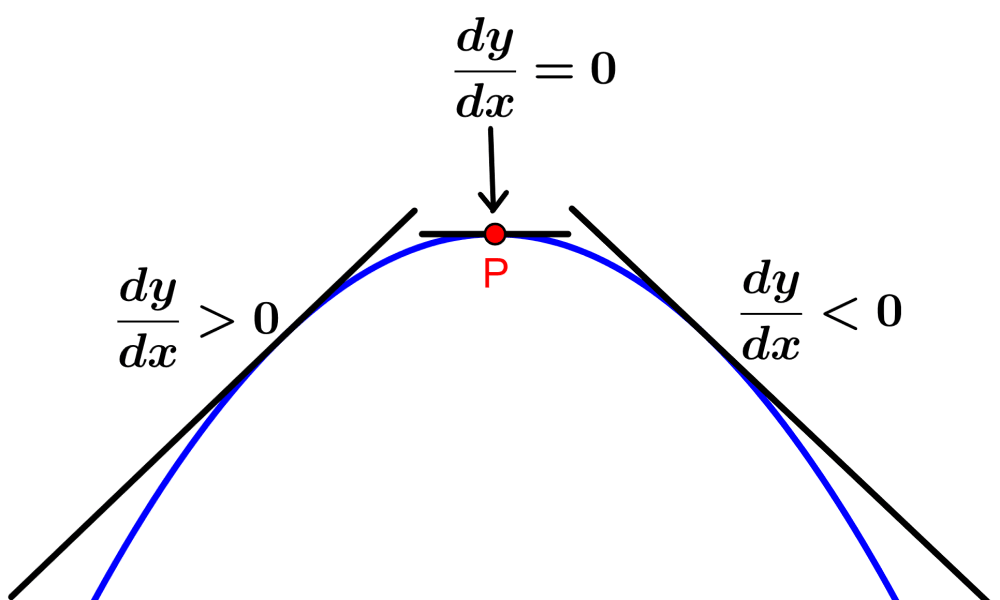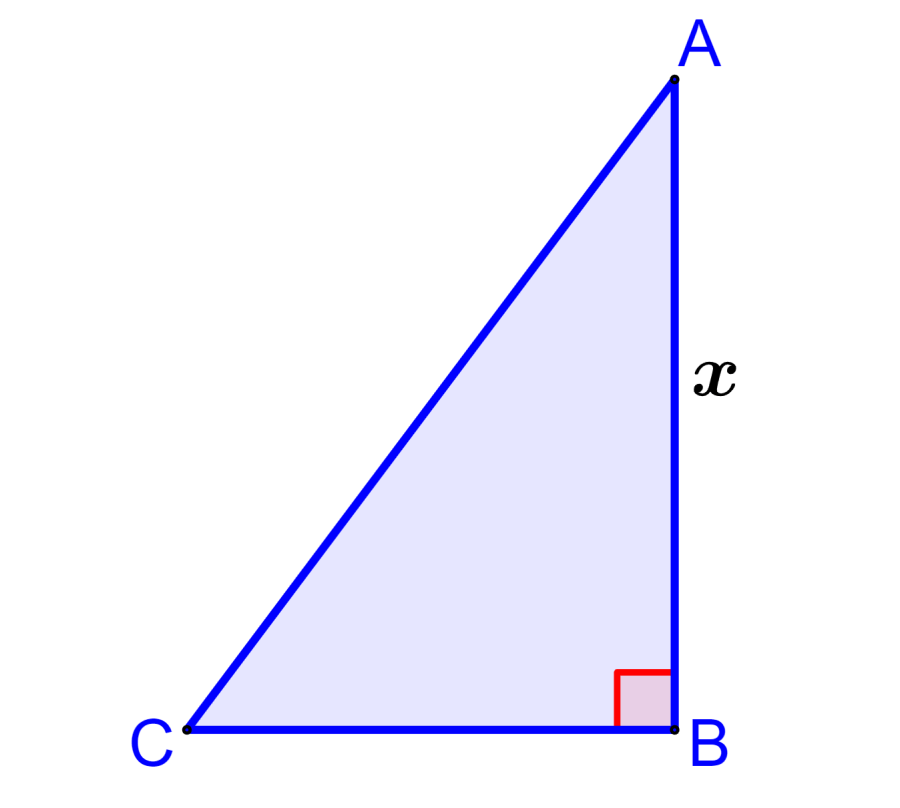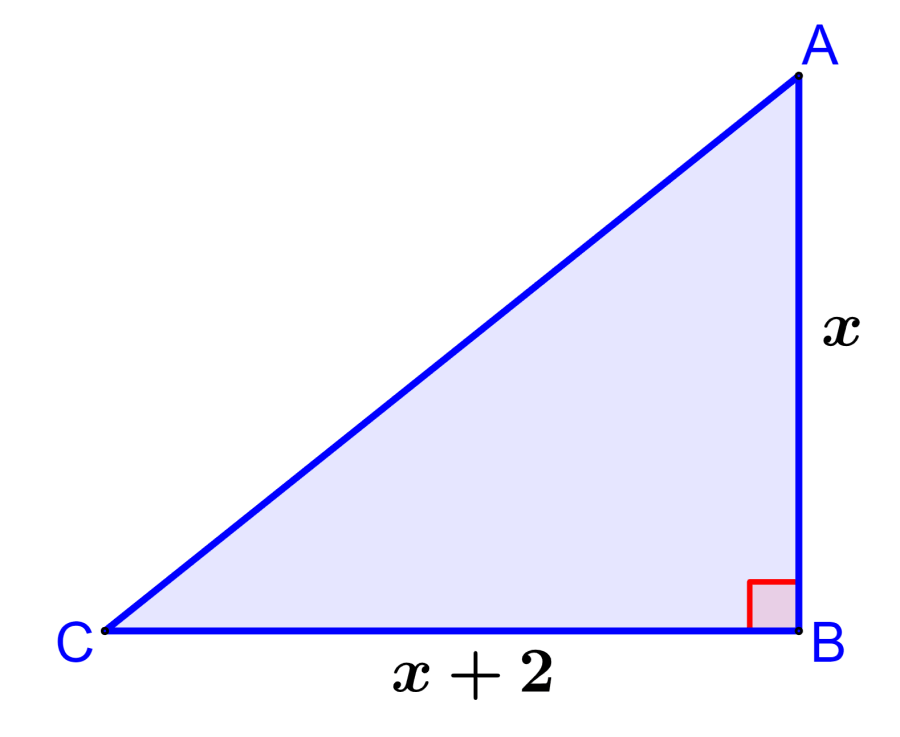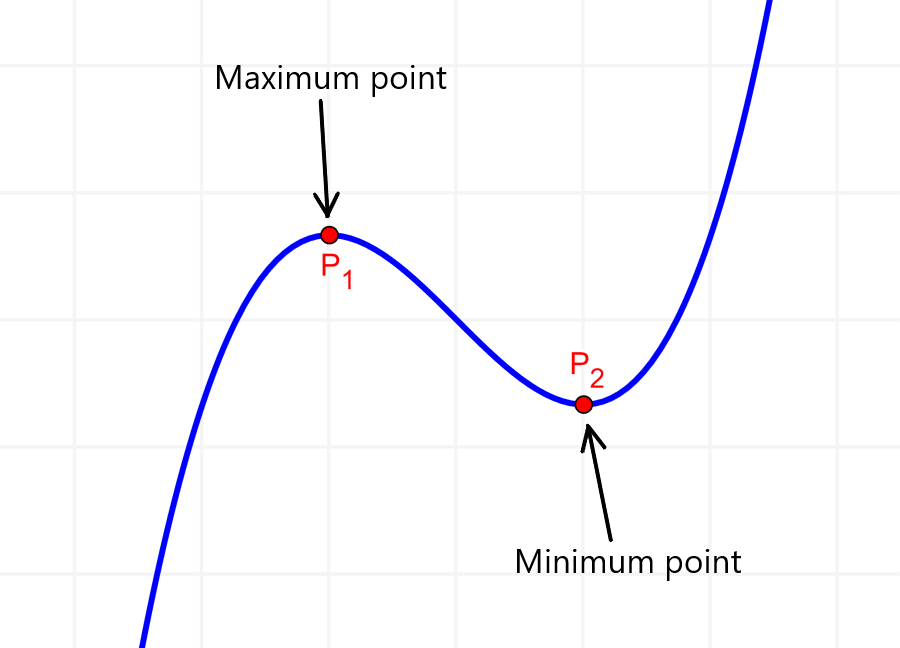The maximum and minimum points of a function are stationary points. These points can be found by forming an equation with the derivative of a function. Then, we can determine which is a minimum and which is a maximum using the second derivative.
Here, we will look at how to find the maxima and minima using the second derivative. We will look at a few examples with answers, as well as practice problems.
How to find the maximum point with the second derivative?
To find the maximum point of a function, we have to start by using the first derivative to determine all the stationary points of the function.
We can achieve this by assuming that the slope at the stationary points of a function is equal to zero. Then, we can form an equation with the derivative and find the values of x.
Next, we use the second derivative to identify the maximum point. At a maximum point, the second derivative is less than zero, that is, it is negative.
The second derivative is negative at a maximum point since the slope (the first derivative) is positive until it reaches the maximum point, and then it is negative. That is, the derivative decreases near the maximum point, as we see in the diagram:

In summary, we find the maximum point of a function with the following steps:
Step 1: Calculate the first derivative of the function.
Step 2: Use the derivative to get the stationary points. Therefore, we form the equation $latex \frac{dy}{dx}=0$ and solve for x.
Step 3: Use the second derivative to identify the maximum point. For the point to be a maximum, we must have $latex \frac{d^2y}{dx^2}<0$.
Step 4: Using the x-coordinate from step 3, we find the y-coordinate of the maximum point.
How to find the minimum point with the second derivative?
To find the minimum point of a function, we use the first derivative to find the stationary points. Then, we form an equation with the derivative and solve for x.
Next, we use the second derivative to identify the minimum point. At a minimum point, the second derivative is greater than zero, that is, it is positive.
The second derivative is positive at a minimum point since the slope (the first derivative) is negative until it reaches the minimum point, and then it is positive. That is, the derivative grows close to the maximum point, as we see in the diagram:

In short, we can find the coordinates of the minimum point of a function with the following steps:
Step 1: Calculate the first derivative of the function.
Step 2: Find the stationary points using the derivative. For this, we form the equation $latex \frac{dy}{dx}=0$ and solve for x.
Step 3: Use the second derivative to identify the minimum point. When we have a minimum point, we must have $latex \frac{d^2y}{dx^2}>0$.
Step 4: Use the x-coordinate from step 3 to find the y-coordinate of the minimum point.
Maxima and minima with second derivative – Examples with answers
EXAMPLE 1
What are the coordinates of the maximum point of the function $latex f(x)=-x^2+2x$?
Solution
To find the maximum point, we have to start by finding all the stationary points. For this, we obtain the derivative of the function
$latex f(x)=-x^2+2x$
$latex f'(x)=-2x+2$
Now, we form an equation with the derivative and find the values of x:
$latex -2x+2=0$
$latex -2x=-2$
$latex x=1$
The value found corresponds to a stationary point. To check if the point is a maximum point, we use the second derivative:
$latex f^{\prime \prime}(x)=-2$
Since $latex f^{\prime \prime}(x)<0$, the found point corresponds to a maximum point.
Using $latex x=1$ in the function, we find the y-coordinate of the maximum point:
$latex y=-x^2+2x$
$latex y=-(1)^2+2(1)$
$latex y=1$
The maximum point has the coordinates (1, 1).
EXAMPLE 2
What are the coordinates of the minimum point of the function $latex f(x)=x^2+2x-1$?
Solution
We start by finding the derivative of the function since we are going to use it to find the stationary points:
$latex f(x)=x^2+2x-1$
$latex f'(x)=2x+2$
We form an equation with the derivative and solve for x:
$latex 2x+2=0$
$latex 2x=-2$
$latex x=-1$
Now, we use the second derivative to check if the point is a minimum point.
$latex f^{\prime \prime}(x)=2$
Since we have $latex f^{\prime \prime}(x)>0$, the point found corresponds to a minimum point.
Finally, we use $latex x=-1$ in the function to determine the y-coordinate of the point:
$latex y=x^2+2x-1$
$latex y=(-1)^2+2(-1)-1$
$latex y=-2$
The minimum point of the function is (-1, -2).
EXAMPLE 3
Determine the maximum point of the function $latex f(x)=-x^3+3x+2$.
Solution
We start by finding the derivative of the function:
$latex f(x)=-x^3+3x+2$
$latex f'(x)=-3x^2+3$
Forming an equation with the derivative, we can solve for x to find the stationary points:
$latex -3x^2+3=0$
$latex -3x^2=-3$
$latex x=\sqrt{3}$
$latex x=1~~$ or $latex ~~x=-1$
Using the second derivative, we can determine the nature of the points found:
$latex f^{\prime \prime}(x)=-6x$
If $latex x=1$, we have $latex f^{\prime \prime}(x)<0$, and if $latex x=-1$, we have $latex f^{\prime \prime }(x)>0$. Then, $latex x=1$ is the maximum point.
We use $latex x=1$ to find the y-coordinate of the maximum point:
$latex y=-x^3+3x+2$
$latex y=-(1)^3+3(1)+2$
$latex y=4$
The maximum point has the coordinates (1, 4).
EXAMPLE 4
Find the coordinates of the minimum point of the function $latex f(x)=x^3-3x-2$.
Solution
The derivative of the function is as follows:
$latex f(x)=x^3-3x-2$
$latex f'(x)=3x^2-3$
Now, we use the derivative to form an equation and solve for x:
$latex 3x^2-3=0$
$latex x=\sqrt{1}$
$latex x=\pm 1$
$latex x=1~~$ or $latex ~~x=-1$
We have two stationary points. Therefore, we have to use the second derivative to determine the nature of these points:
$latex f^{\prime \prime}(x)=6x$
When $latex x=1$, we have $latex f^{\prime \prime}(x)>0$ and when $latex x=-1$, we have $latex f^{\prime \prime}(x)< 0$. Thus, $latex x=1$ is the minimum point.
We find the y-coordinate of the minimum point using $latex x=1$ in the function:
$latex y=x^3-3x-2$
$latex y=(1)^3-3(1)-2$
$latex y=-4$
The minimum point of the function is (1, -4).
EXAMPLE 5
What are the coordinates of the maximum point of the function $latex f(x)=2x^3-6x+5$?
Solution
The derivative of the function is:
$latex f(x)=2x^3-6x+5$
$latex f'(x)=6x^2-6$
We can find the x-values of the stationary points by forming an equation with the derivative:
$latex 6x^2-6=0$
$latex 6x^2=6$
$latex x^2=\sqrt{1}$
$latex x=1~~$ or $latex ~~x=-1$
Now, we use the second derivative to determine the nature of these points:
$latex f^{\prime \prime}(x)=12x$
When $latex x=1$, we have $latex f^{\prime \prime}(x)>0$ and when $latex x=-1$, we have $latex f^{\prime \prime}(x)< 0$, so $latex x=-1$ is the maximum point.
We find the y-coordinate of the maximum point as follows:
$latex y=2x^3-6x$
$latex y=2(-1)^3-6(-1)$
$latex y=4$
The maximum point has the coordinates (-1, 4).
EXAMPLE 6
If we have the function $latex f(x)=2x^3-6x-4$, find its minimum point.
Solution
We find the derivative of the function as follows:
$latex f(x)=2x^3-6x-4$
$latex f'(x)=6x^2-6$
We can find the stationary points by forming an equation with the derivative and solving for x:
$latex 6x^2-6=0$
$latex x=\sqrt{1}$
$latex x=\pm 1$
$latex x=1~~$ or $latex ~~x=-1$
We have two stationary points, so we use the second derivative to determine their nature:
$latex f^{\prime \prime}(x)=12x$
When $latex x=1$, we have $latex f^{\prime \prime}(x)>0$ and when $latex x=-1$, we have $latex f^{\prime \prime}(x)< 0$. This means that $latex x=1$ is the minimum point.
Finally, we find the y-coordinate of the point:
$latex y=2x^3-6x-4$
$latex y=2(1)^3-6(1)-4$
$latex y=-8$
The minimum point of the function is (1, -8).
EXAMPLE 7
Find the coordinates of the maximum point of $latex f(x)=\frac{1}{3}x^3+x^2-3x$.
Solution
We start by finding the derivative of the function:
$latex f(x)=\frac{1}{3}x^3+x^2-3x$
$latex f'(x)=x^2+2x-3$
Now, let’s form an equation with the derivative and solve by factoring:
$latex x^2+2x-3=0$
$latex (x+3)(x-1)=0$
$latex x=-3~~$ or $latex ~~x=1$
We found two stationary points, so we can use the second derivative to determine the nature of these points:
$latex f^{\prime \prime}(x)=2x+2$
When $latex x=-3$, we have $latex f^{\prime \prime}(x)<0$ and when $latex x=1$, we have $latex f^{\prime \prime}(x)> 0$. Thus, the maximum point is at $latex x=-3$.
Finally, we find the y-coordinate of the point using $latex x=-3$ in the function:
$latex f(x)=\frac{1}{3}x^3+x^2-3x$
$latex f(x)=\frac{1}{3}(-3)^3+(-3)^2-3(-3)$
$latex y=9$
The maximum point has the coordinates (-3, 9).
EXAMPLE 8
What are the coordinates of the minimum point of the function $latex f(x)=-\frac{1}{3}x^3+x^2+3x$?
Solution
We start by finding the derivative of the function and forming an equation to get the stationary points:
$latex f(x)=-\frac{1}{3}x^3+x^2+3x$
$latex f'(x)=-x^2+2x+3$
$latex -x^2+2x+3=0$
$latex -(x-3)(x+1)=0$
$latex x=3~~$ or $latex ~~x=-1$
Now, we use the second derivative
$latex f^{\prime \prime}(x)=-2x+2$
When $latex x=3$, we have $latex f^{\prime \prime}(x)<0$ and when $latex x=-1$, we have $latex f^{\prime \prime}(x)> 0$. This means that $latex x=-1$ is the minimum point.
Finally, we determine the y-coordinate of the minimum point:
$latex y=-\frac{1}{3}x^3+x^2+3x$
$latex y=-\frac{1}{3}(-1)^3+(-1)^2+3(-1)$
$latex y=-\frac{5}{3}$
The minimum point of the function is $latex (-1, ~-\frac{5}{3})$.
EXAMPLE 9
In the following right triangle ABC, the lengths of the sides AB and BC vary in such a way that their sum is always equal to 6 cm. Find the maximum area of triangle ABC.

Solution
We can solve this problem by finding a function of the area in terms of x. For this, we observe the following:
$latex AB+BC=6$
$latex x+BC=6$
$latex BC=6-x$
Then, we can use the triangle area formula to get:
$latex A=\frac{1}{2}\times BC \times AB$
$latex A=\frac{1}{2}(6-x)x$
$latex A=3x-\frac{x^2}{2}$
Now, we have to find the derivative to form an equation and find the stationary points:
$latex A(x)=3x-\frac{x^2}{2}$
$latex A'(x)=3-x$
$latex 3-x=0$
$latex x=3$
We check whether this point is a maximum point using the second derivative:
$latex A^{\prime \prime}(x)=-1$
Since $latex f^{\prime \prime}(x)<0$, we know that point is a maximum. Then, we use $latex x=3$ to find the maximum area:
$latex A=3x-\frac{x^2}{2}$
$latex A=3(3)-\frac{(3)^2}{2}$
$latex A=\frac{9}{2}=4.5$
The maximum area of the triangle is 4.5 cm².
EXAMPLE 10
The following right triangle ABC has sides with lengths AB=x and BC=x+2. Find the minimum area of triangle ABC.

Solution
Similar to the previous exercise, we have to find a function for the area of the triangle using the given information:
$latex A=\frac{1}{2}\times BC \times AB$
$latex A=\frac{1}{2}(x+2)x$
$latex A=\frac{1}{2}x^2+x$
Now, we find the derivative to form an equation and find the stationary points:
$latex A(x)=\frac{1}{2}x^2+x$
$latex A'(x)=x+1$
$latex x+1=0$
$latex x=-1$
To check if the point is a minimum, we are going to use the second derivative:
$latex A^{\prime \prime}(x)=1$
We have $latex f^{\prime \prime}(x)>0$, so we confirm that the point is a minimum. Then, we use $latex x=-1$ to find the minimum area:
$latex A=\frac{1}{2}x^2+x$
$latex A=\frac{1}{2}(-1)^2-1$
$latex A=-\frac{1}{2}=0.5$
The minimum area of the triangle is 0.5 cm².
Maxima and minima with second derivative – Practice problems


Find the coordinates of the minimum point of $latex f(x)=-1+4x+2x^2$.
Write the answer in the input box.
See also
Interested in learning more about derivatives and stationary points? You can look at these pages:




